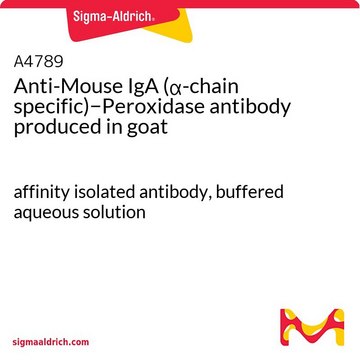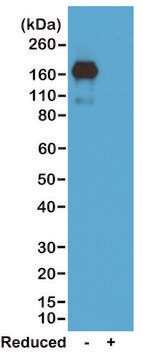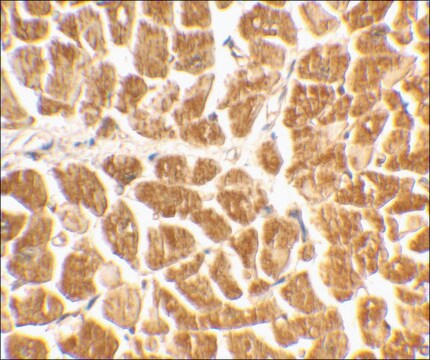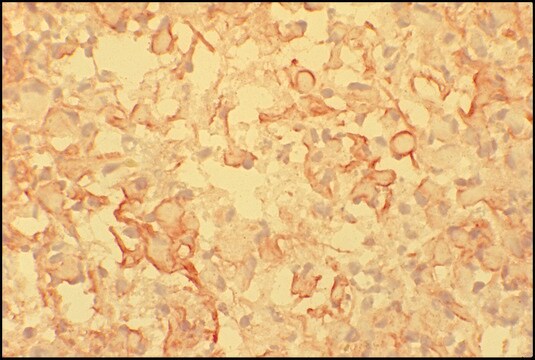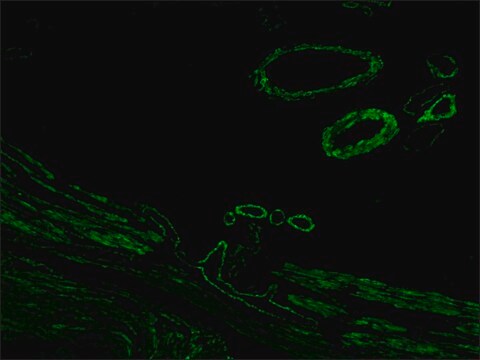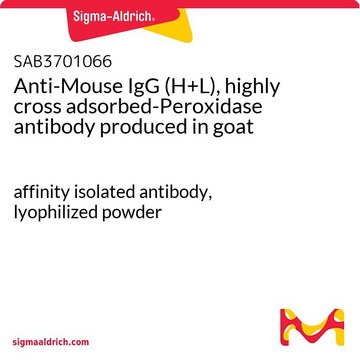F9384
Anti-Mouse IgA (α-chain specific)−FITC antibody produced in goat
affinity isolated antibody, buffered aqueous solution
Sinónimos:
Goat Anti-Mouse IgA (α-chain specific)−Fluorescein isothiocyanate
Iniciar sesiónpara Ver la Fijación de precios por contrato y de la organización
About This Item
Productos recomendados
origen biológico
goat
conjugado
FITC conjugate
forma del anticuerpo
affinity isolated antibody
tipo de anticuerpo
secondary antibodies
clon
polyclonal
Formulario
buffered aqueous solution
técnicas
direct immunofluorescence: 1:16
temp. de almacenamiento
2-8°C
modificación del objetivo postraduccional
unmodified
Descripción general
IgA antibody is secretory antibody and is present abundantly in mucous linings of gastrointestinal, respiratory and genitourinary tracts, tears and saliva. Thus secretory IgA contributes to the humoral defense mechanism against the pathogens on mucosal surfaces
Anti-Mouse IgA (α-chain specific)−FITC antibody is specific for α chain of mouse IgA. The purified IgA fraction is conjugated to Fluorescein Isothiocyanate (FITC), Isomer I.
Anti-Mouse IgA (α-chain specific)−FITC antibody is specific for α chain of mouse IgA. The purified IgA fraction is conjugated to Fluorescein Isothiocyanate (FITC), Isomer I.
Inmunógeno
Purified mouse IgA
Aplicación
Anti-Mouse IgA (α-chain specific)−FITC antibody may be used for direct immunofluorescent labeling of mouse spleen cells at a minimum working dilution of 1:16. The antibody was used to label platelets from human or mice after incubation with primary antibody against β3 integrin.
Forma física
Solution in 0.01 M phosphate buffered saline, pH 7.4, containing 1% bovine serum albumin and 15 mM sodium azide.
Cláusula de descargo de responsabilidad
Unless otherwise stated in our catalog or other company documentation accompanying the product(s), our products are intended for research use only and are not to be used for any other purpose, which includes but is not limited to, unauthorized commercial uses, in vitro diagnostic uses, ex vivo or in vivo therapeutic uses or any type of consumption or application to humans or animals.
¿No encuentra el producto adecuado?
Pruebe nuestro Herramienta de selección de productos.
Código de clase de almacenamiento
10 - Combustible liquids
Clase de riesgo para el agua (WGK)
WGK 1
Punto de inflamabilidad (°F)
Not applicable
Punto de inflamabilidad (°C)
Not applicable
Elija entre una de las versiones más recientes:
¿Ya tiene este producto?
Encuentre la documentación para los productos que ha comprado recientemente en la Biblioteca de documentos.
Los clientes también vieron
Heidi Tiller et al.
Transfusion, 52(7), 1446-1457 (2012-01-19)
Fetal and neonatal alloimmune thrombocytopenia (FNAIT) is a severe bleeding disorder caused by maternal antibody-mediated destruction of fetal or neonatal platelets (PLTs). Results from our recent large screening study suggest that the pathophysiology of FNAIT is more similar to hemolytic
B Manoury-Schwartz et al.
European journal of immunology, 25(12), 3235-3242 (1995-12-01)
Native type II collagen (CII) is a high molecular-weight fibrillar molecule which induces a chronic polyarthritis in mice expressing the H-2q haplotype. The present study was initiated to analyze the processing and the presentation of this nonglobular protein by H-2q
Hao-Jing Wen et al.
Molecular medicine reports, 19(1), 660-666 (2018-11-16)
A high level of oxidized low‑density lipoproteins (oxLDLs) is an independent risk factor for cardiovascular disease. The aim of the present study was to investigate whether insulin‑like growth factor‑1 (IGF‑1) protected endothelial progenitor cells (EPCs) from injury caused by ox‑LDLs
Robert W Garvey et al.
ChemMedChem, 17(10), e202100759-e202100759 (2022-03-15)
Mounting evidence suggests that the serotonin system serves in signal transmission to regulate insulin secretion in pancreatic islets of Langerhans. Among the 5-HT receptor subtype found in pancreatic islets, serotonin receptor 1A (5-HT1A ) demonstrates a unique ability to inhibit
D C Shieh et al.
Autoimmunity, 15(2), 123-135 (1993-01-01)
Type I, insulin-dependent diabetes (IDD) results from an autoimmune response against the insulin producing pancreatic beta cells. This autoimmune reaction involves both humoral and cell-mediated factors; nevertheless, the relative role of each remains unresolved. Furthermore, while adoptive transfer experiments have
Nuestro equipo de científicos tiene experiencia en todas las áreas de investigación: Ciencias de la vida, Ciencia de los materiales, Síntesis química, Cromatografía, Analítica y muchas otras.
Póngase en contacto con el Servicio técnico